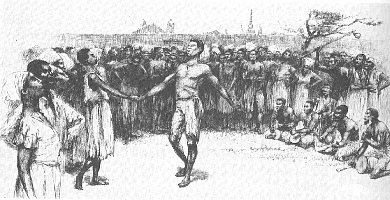Video clips from a drum circle in Congo Square, New Orleans from 2015, including shots of Mardi Gras Indians around 2:30 (video from DanieleCreole from Youtube)
As tragic and inhumane as slavery was, it played a key role in the development of jazz through introducing African elements into the American musical vocabulary. Wynton Marsalis, a trumpeter and one of the greatest living jazz
musicians, characterized jazz as a music that “broke the rules of European
conventions and created rules of its own that were so specific, so thorough and
so demanding that a great art resulted” (1).
 |
| Wynton Marsalis (image by music 2020 from Flickr, CC BY) |
These
gatherings were regularly held until late in the 1800s. While they seemed like celebrations to
outsiders, these gatherings were, in fact, based on West and West Central
African festivals that “[spoke] to the very real concerns” of the slaves and
were part of the “resistance-focused ethos [and] expressive culture” of
Africans in the New World as Daniel Walker points out (2).
 |
| An 1885 illustration of a Congo Square gathering from E.W. Kemble (image from Wikimedia Commons, Public Domain) |
These
gatherings began to draw crowds of onlookers, both whites and Native
Americans like the Mardi Gras Indians. Eventually, these native groups joined in the
celebrations, adding their own musical concepts to the mix. Among the white onlookers were a number of
musicians who began to experiment with more complex rhythms in their own
music, drawn primarily from European folk and classical traditions. This synthesis of European concepts of melody
and harmony combined with African and Native American rhythms, especially the
central role of drums, became jazz, which has had a strong effect on American
and world music for more than a hundred years. Congo Square is now part of the Luis
Armstrong Park and the site of jazz performances and drum circles that honor
the place’s musical legacy.
 |
| A brass band plays in Congo Square during the 2013 New World Rhythm Festival (image by Derek Bridges from Flickr, CC BY) |
1. Marsalis, W. (July
31, 1988). What jazz is-and isn’t. The New
York Times. Retrieved 24 March 2016
from http://www.nytimes.com/1988/07/31/arts/music-what-jazz-is-and-isn-t.html?pagewanted=all
2. Walker, D. E.
(2004). No more, no more: Slavery and cultural resistance in Havana and New
Orleans. Minneapolis: University of
Minnesota Press. Retrieved 24 March 2016
from ProQuest ebrary.



No comments:
Post a Comment